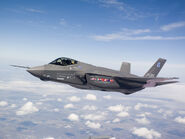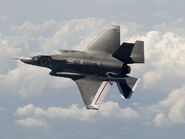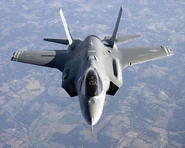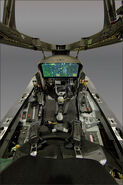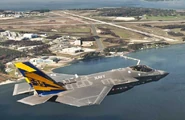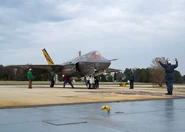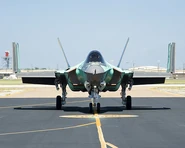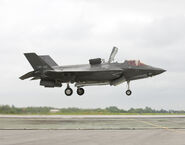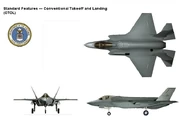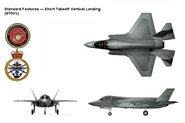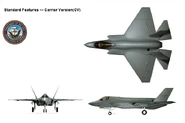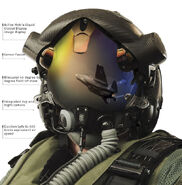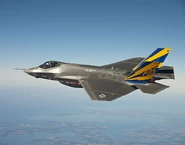m (fixing dead links) |
(Infobox correction) Tag: Visual edit |
||
| Line 14: | Line 14: | ||
|- |
|- |
||
|Passengers |
|Passengers |
||
| − | | colspan="2"| |
+ | | colspan="2" |0 |
|- |
|- |
||
|First flight |
|First flight |
||
Revision as of 22:36, 18 January 2015
| Lockheed Martin F-35 Lightning II | ||
|---|---|---|
| Description | ||
| Role | Stealth multirole fighter | |
| Crew | 1 | |
| Passengers | 0 | |
| First flight | 2006 | |
| Entered service | In development | |
| Manufacturer | Lockheed Martin | |
| Produced | 24 ( as of december 2011) | |
| Dimensions | ||
| Length | 15,67 m | |
| Wingspan | 10,67 m | |
| Height | 4,57 m | |
| Wing area | 42,70 m² (F-35C: 62,06 m²) | |
| Weights | ||
| Empty | 13170 kg | |
| Loaded | 22280 kg | |
| Maximum takeoff | 30000 kg | |
| Powerplant | ||
| Engine | ||
| Power (each) | ||
| Performance | ||
| Maximum speed | Greater than Mach 1.6 | |
| Cruising speed | ||
| Range | 2222 km | |
| Ceiling | 15240 m | |
| Rate of climb | classified | |
The F-35 Lightning II was the winner of the Joint Strike Fighter program. It is a single-seat single-engine multi-role fighter under development. It is intended to carry out ground attacks, reconnaissance, and air defense missions with stealth capability. It is the first stealth multi-role fighter.
Development
JSF Program history
Requirement
The JSF program was created to replace various aircraft while keeping development, production, and operating costs down. This was pursued by building three variants of one aircraft, sharing 80% of their parts:
- F-35A, conventional takeoff and landing (CTOL) variant.
- F-35B, short-takeoff and vertical-landing (STOVL) variant.
- F-35C, carrier-based (CATOBAR) variant.
The F-35 is being designed to be the world's premier strike aircraft through 2040. It is intended that its air to air capability will be second only to the F-22 Raptor. Specifically the F-35’s equirements are that it be: four times more effective than legacy fighters in air to air combat, eight times more effective in air to ground battle combat, and three times more effective in reconnaissance and suppression of air defenses. These capabilities are to be achieved while still having significantly better range and a smaller logistical footprint than legacy aircraft.[5]
Origins and X-32 vs. X-35
File:X-32 X-35 Cdp misc 004.jpgBoeing X-32 (left) and Lockheed Martin X-35 prior to down-select in 2001, where the X-35 was chosen.The Joint Strike Fighter evolved out of several requirements for a common fighter to replace existing types. The actual JSF development contract was signed on 16 November 1996.
The contract for System Development and Demonstration (SDD) was awarded on 26 October 2001 to Lockheed Martin, whose X-35 beat the Boeing X-32. DoD officials and British Minister of Defence Procurement Lord Bach, said the X-35 consistently outperformed the X-32, although both met or exceeded requirements. The designation of the fighter as "F-35" came as a surprise to Lockheed, which had been referring to the aircraft in-house by the designation "F-24."[6]
Naming
On 7 July 2006, the U.S. Air Force officially announced the name of the F-35: Lightning II,[7] in honor of Lockheed's World War II-era twin-prop P-38 Lightning and the Cold War-era jet, the English Electric Lightning. English Electric's aircraft division was incorporated into British Aircraft Corporation, a predecessor of F-35 partner BAE Systems. Other names previously listed as contenders were Kestrel, Phoenix, Piasa, Black Mamba and Spitfire II. Lightning II was also an early company name for the aircraft that became the F-22 Raptor.
Design
File:F-35A - Inauguration Towing.jpgThe F-35A being towed to its inauguration ceremony on 7 July 2006The F-35 appears to be a smaller, slightly more conventional, one-engine sibling of the sleeker, two-engine F-22 Raptor, and indeed, drew elements from it. The exhaust duct design was inspired by the General Dynamics Model 200, a 1972 VTOL aircraft designed for the Sea Control Ship.[8]
Lockheed teamed with the Yakovlev Design Bureau in the 1990s, which has led to some speculation about ties with the quite different Yakovlev Yak-141 'Freestyle'.[9]
Stealth technology makes the aircraft hard to detect as it approaches short-range tracking radar.
Some improvements over current-generation fighter aircraft are:
- Durable, low-maintenance stealth technology;
- Integrated avionics and sensor fusion that combine information from off- and onboard sensors to increase the pilot's situational awareness and improve identification and weapon delivery, and to relay information quickly to other command and control (C2) nodes;
- High speed data networking including IEEE-1394b[10] and Fibre Channel.[11]
- Low life-cycle costs.Template:Fact
- Will feature a voice-recognition system, improving the pilot's ability to operate the aircraft. The F-35 will be the first U.S. aircraft with such a system.[12]
Although helmet-mounted displays have already been integrated into some fourth-generation fighters such as the Swedish JAS 39 Gripen, the F-35 will be the first in which helmet-mounted displays replace a head-up display altogether.[13]
Sensors
File:F-35 EOTS.jpegEOTS under the nose of a mockup of the F-35.The main sensor on board the F-35 is its AN/APG-81 AESA-radar, designed by Northrop Grumman Electronic Systems.[14] It is augmented by the Electro-Optical Targeting System (EOTS) mounted under the nose of the aircraft, designed by Lockheed Martin and BAE.[15] Further electro-optical sensors are distributed over the aircraft as part of the AN/AAS-37 system which acts as missile warning system and can aid in navigation and night operations.
Thrust-to-weight ratio
The F-35B variant was in danger of missing performance requirements because it weighed too much — reportedly, by 2,200 pounds (1,000 kg) or 8 percent. In response, Lockheed Martin added engine thrust and shed more than a ton by thinning the aircraft's skin; shrinking the weapons bay and vertical tails; rerouting some thrust from the roll-post outlets to the main nozzle; and redesigning the wing-mate joint, portions of the electrical system, and the portion of the aircraft immediately behind the cockpit.[16]
Manufacturing responsibilities
Lockheed Martin Aeronautics is the prime contractor and performs aircraft final assembly, overall system integration, mission system, and provides forward fuselage, wings and flight controls system. Northrop Grumman provides Active Electronically Scanned Array (AESA) radar, center fuselage, weapons bay, and arrestor gear. BAE Systems provides Aft fuselage and empennages, horizontal and vertical tails, crew life support and escape systems, Electronic warfare systems, fuel system, and Flight Control Software (FCS1). Alenia will perform final assembly for Italy and, according to an Alenia executive, assembly of all European aircraft with the exception of the UK's.[17]
Operational history
The F-35A Lightning II's first flight on 15 December 2006. On 19 February 2006, the first F-35A (USAF version) was rolled out in Fort Worth, Texas. The aircraft underwent extensive ground testing at Naval Air Station Fort Worth Joint Reserve Base in fall 2006. On 15 September 2006 the first engine run of the F135 afterburning turbofan was conducted in an airframe, with the tests completed on 18 September after a static run with full afterburner. The engine runs were the first time that the F-35 was completely functional on its own power systems.[18] On 15 December 2006, the F-35 completed its maiden flight.
International participation
While the United States is the primary customer and financial backer, the United Kingdom, Italy, the Netherlands, Canada, Norway, Denmark, Australia and Turkey have contributed US$4.375 billion toward the development costs of the program.[1] Total development costs are estimated at more than US$40 billion (underwritten largely by the United States), while the purchase of an estimated 2,400 planes is expected to cost an additional US$200 billion.[19] The nine major partner nations plan to acquire over 3,100 F-35s through 2035,[20] making the F-35 one of the most prolific jet fighters.
There are three levels of international participation. The levels generally reflect the financial stake in the program, the amount of technology transfer and subcontracts open for bid by national companies, and the order in which countries can obtain production aircraft. The United Kingdom is the sole "Level 1" partner, contributing US$2.5 billion, about 10% of the development costs[21] under the 1995 Memorandum of Understanding that brought the UK into the project.[22] Level 2 partners are Italy, which is contributing US$1 billion; and the Netherlands, US$800 million. Level 3 partners are Canada, US$440 million; Turkey, US$175 million; Australia, US$144 million; Norway, US$122 million; and Denmark, US$110 million. Israel and Singapore have joined as Security Cooperative Participants.[23]
Some of the partner countries have wavered in their public commitment to the JSF program, hinting or warning that unless they receive more subcontracts or technology transfer, they will forsake JSF for the Eurofighter Typhoon, Saab Gripen, Dassault Rafale or simply upgrade their existing aircraft. Norway has several times threatened to put their support on hold unless substantial guarantees for an increased industrial share is provided. Despite this Norway has signed all the Memoranda of Understanding, including the latest one detailing the future production phase of the JSF program. They have, however, indicated that they will increase and strengthen their cooperation with both competitors of the JSF, the Typhoon and the Gripen.[24]
United Kingdom
Template:Main The United Kingdom plans to acquire versions of the F-35 for its Royal Air Force and the Royal Navy.
The UK became increasingly frustrated by a lack of US commitment to grant access to the technology that would allow the UK to maintain and upgrade its F-35s without US involvement. This is understood to relate mainly to the software of the vehicle. For five years, British officials sought an ITAR waiver to secure greater technology transfer. This request, which has the blessing of the Bush administration, has been repeatedly blocked by US Representative Henry Hyde, who says that the UK needs to tighten its laws protecting against the unauthorized transfer of the most advanced US technology to third parties.[25]
BAE Systems CEO Mike Turner complained that the US had denied his company access to the aircraft's source code. On 21 December 2005, an article in the Glasgow Herald quoted the chairman of the House of Commons Defence Select Committee as saying "the UK might have to consider whether to continue in the programme" if no access were granted.[26] Lord Drayson, Minister for Defence Procurement, took a firmer stance during a March 2006 visit to Washington: "We do expect the software technology transfer to take place. But if it does not take place we will not be able to purchase these aircraft," and he said there was a 'Plan B' if the deal fell through.[27] This may have been the development of a navalized Typhoon.[28]
On 27 May 2006, President George W. Bush and Prime Minister Tony Blair announced that "Both governments agree that the UK will have the ability to successfully operate, upgrade, employ, and maintain the Joint Strike Fighter such that the UK retains operational sovereignty over the aircraft."[29] Despite this, concerns were still expressed about the lack of technology transfer as late as December 2006. Nevertheless, on 12 December 2006, Lord Drayson signed an agreement which met the UK's demands for further participation, i.e., access to software source codes and operational sovereignty. The agreement allows "an unbroken British chain of command" for operation of the aircraft. Drayson said Britain would "not be required to have a US citizen in our own operational chain of command".[30] Drayson also said, however, that Britain is still considering an unspecified "Plan B" alternative to buying the Joint Strike Fighter.
On 25 July 2007, the Ministry of Defence confirmed that they have placed orders for the two new aircraft carriers of the Queen Elizabeth Class, that will allow the purchase of the F-35B variant.[31]
Australia
File:Aust JST USN.jpgAustralian Minister for Defence Dr Brendan Nelson signing the JSF Production, Sustainment and Follow-on Development Memorandum of Understanding in December 2006In May 2005, the Australian government announced that it would delay its planned 2006 decision on buying the JSF to 2008, and thus past the term of the present government. Australia, like the UK, has insisted it must have access to all software needed to modify and repair aircraft. Analysis conducted by the Royal Australian Air Force has determined that the F-35 "is the most suitable aircraft for Australia’s needs".[32]
There has been debate in Australia over whether the F-35 is the most suitable aircraft for the RAAF. Some media reports, lobby groups and politicians have raised doubts that the aircraft will be ready in time to replace the RAAF's aging fleet of General Dynamics F-111 strike aircraft and F/A-18 Hornet fighters. Some critics say the more expensive F-22 or the Eurofighter may be better choices, both offering better range, dogfighting capability, and supercruise at a cost that may not be much more than the F-35,as well as the F-22 has more advanced avionics[33] — claims that as of July 2006 are being examined in a parliamentary inquiry.[34]
In a statement released in early August 2006, Australian Defence Minister Dr. Brendan Nelson revealed that whilst the F-35 still had governmental support, Australia is starting to investigate other possible aircraft should the F-35 prove to be unfeasible.[35] In October 2006 the deputy chief of the Air Force, Air Vice Marshal John Blackburn, publicly stated that the RAAF had ruled out the purchase of interim strike aircraft to cover any delays to the F-35 program and believed that the F-35 was suitable.[36] However, on 6 March 2007, Dr. Nelson announced the Australian Government would purchase 24 F/A-18F Super Hornets from Boeing to fill the gap left by the retiring F-111 strike aircraft at a cost of potentially A$6 billion.[37] Nonetheless, Dr. Nelson says he continues to endorse Australia’s purchase of the F-35. Speaking on Australian television in March 2007, Dr. Nelson stated that 5% of the capability of the F-35 is classified, claiming that, "that's the five percent that really counts."[38]
On 13 December 2006, Minister Nelson signed the JSF Production, Sustainment and Follow-on Development Memorandum of Understanding. This agreement provides the cooperative framework for the acquisition and support of the JSF over its life.[39] Australia is expected to purchase 100 F-35As at a cost of approximately $16 billion AUD.[40]
Turkey
On 12 July 2002, Turkey became the seventh international partner in the JSF Project, joining the United Kingdom, Italy, the Netherlands, Canada, Denmark and Norway. On 25 January 2007, Turkey signed a memorandum of understanding (MoU) for involvement in F-35 production. Turkey is expected to order 100 F-35A "CTOL/Air Force versions" at a reported cost of $11 billion.[41] It is reported that the aircraft will be produced under license in Turkey by Turkish Aerospace Industries (TAI).
A Letter of Intent (LOI) was signed between TAI and Northrop Grumman ISS (NGISS) International on 6 February 2007. With the LOI, TAI becomes the second source for the F-35 Lightning II center fuselage during the JSF Signing. The number of center fuselages to be produced by TAI will be determined depending on the number of F-35s Turkey will procure and the number of F-35s to be produced worldwide. The LOI represents a potential value in excess of $3 billion.Template:Fact
Canada
The Canadian Department of National Defence (DND) is looking to replace its aging fleet of CF-18 Hornets by the 2020 timeframe with much interest placed on the F-35. DND officials have stated the estimate for producing 80 units would cost 3.8 billion, though this figure does not include training, sustainment, and any follow on costs. Canada has until 2012 to decide on purchasing the F-35, though they have already invested $150 million in the JSF program.[42]
Other nations
Israel
In 2003, Israel signed a letter of agreement, worth almost $20 million, to formally join the system development and demonstration (SDD) effort for the F-35 as a "security cooperation participant" (SCP).[43] The Israeli Air Force (IAF) stated in 2006 that the F-35 is a key part of IAF's recapitalization plans, and that Israel intends to buy over 100 F-35A fighters at an estimated cost of over $5 billion to replace their F-16s over time, after the F-22 was banned on exports.[44] Israel was temporarily reinstated as a partner in the development of the F-35 on 31 July 2006, after Israeli participation was put on hold following the Chinese arms deal crisis.[45]
On 3 September 2007 IDF Chief of General Staff Lt.-Gen. Gabi Ashkenazi announced the purchase a squadron of F-35s which Israel will begin receiving in 2014. The price of each F-35 is expected to reach $50 million-$60m.[46]
India
The F-35 is a potential offer to the Indian Air Force as of July 2007. This has been interpreted as part of a tactic to sell the F-16 as a multi-role fighters to the IAF.[47]
Pakistan
The Pakistani government is looking to replace its fleet of F-16s by 2020. Recently the Air Force has shown serious interest in the F-35 as the possible successor.Template:Fact
Variants
The F-35 is planned to be built in three different versions to suit the needs of its various users.

The first F-35 headed to the US Air Force
F-35A
The F-35A, the conventional takeoff and landing (CTOL) variant intended for the US Air Force and other air forces. It is the smallest, lightest F-35 version and is the only variant equipped with an internal gun, the GAU-12/U. This 25 mm cannon, a development of the 20 mm M61 Vulcan carried by USAF fighters since the F-104 Starfighter, is also carried by the USMC's AV-8B Harrier II.
The F-35A not only matches the F-16 in maneuverability, instantaneous and sustained high-g performance, but also outperforms it in stealth, payload, range on internal fuel, avionics, operational effectiveness, supportability and survivability.It also has an internal laser designator and infra-red sensors.
It is primarily intended to replace both the USAF's F-16 Fighting Falcons and A-10 Thunderbolt IIs, beginning in 2011.
F-35B
X-35B lift fan; the VTOL propulsion system is designed and manufactured by Rolls-Royce plcThe F-35B is the short takeoff and vertical landing (STOVL) variant aircraft. The F-35B is similar in size to the Air Force F-35A, trading fuel volume for vertical flight systems. Like the AV-8 Harrier II, guns will be carried in a ventral pod. Vertical flight is by far the riskiest, and in the end, a decisive factor in design.
The F-35's main power plant is derived from Pratt & Whitney's F119 or GE Rolls Royce fighter team's F136, with the STOVL variant of the latter incorporating a Rolls-Royce Lift Fan module. Instead of lift engines, or rotating nozzles on the engine fan and exhaust like the Pegasus-powered Harrier, the F-35B uses a vectoring cruise nozzle in the tail, i.e. the rear exhaust turns to deflect thrust down, and an innovative shaft-driven Lift Fan, patented by Lockheed Martin and developed by Rolls-Royce.[48] Somewhat like a turboprop built within the fuselage, engine shaft power is diverted forward via a clutch-and-bevel gearbox to a vertically mounted, contra-rotating lift fan located forward of the main engine in the center of the aircraft. Bypass air from the cruise engine turbofan exhausts through a pair of roll-post nozzles in the wings on either side of the fuselage, while the lift fan balances the vectoring cruise nozzle at the tail. This system is more similar to the Russian Yak-141 and German VJ 101D/E[49] than previous STOVL designs, such as the Harrier with thrust vectoring.
In effect, the F-35B power plant acts as a flow multiplier, much as a turbofan achieves efficiencies by moving unburned air at a lower velocity, and getting the same effect as the Harrier's huge, but supersonically impractical, main fan. Like lift engines, this added machinery is dead weight during flight, but increased lifting power increases takeoff payload by even more. The cool fan exhaust also reduces the harmful effects of hot, high-velocity air which can harm runway pavement or an aircraft carrier deck. Though potentially risky and complicated, it was made to work to the satisfaction of DOD officials.
This variant is intended to replace the later derivatives of the Harrier Jump Jet, which was the world's first operational short takeoff / vertical landing fighter/ground attack aircraft. The RAF and Royal Navy will use this variant to replace the Harrier GR7/GR9s. The U.S. Marine Corps will use the F-35B to replace both its AV-8B Harrier II and F/A-18 Hornet fighters. The B variant is expected to be available beginning in 2012.
F-35C
The F-35C naval variant will have a larger, folding wing and larger control surfaces for improved low-speed control, and stronger landing gear for the stresses of carrier landings. The larger wing area provides increased range and payload, with twice the range on internal fuel compared with the F/A-18C Hornet, achieving much the same goal as the heavier F/A-18E/F Super Hornet.
The US Navy intends to buy 480 F-35Cs to replace the F/A-18A, -B, -C, and -D Hornets. It will also serve as a stealthier complement to the Super Hornet.[50] On 27 June 2007, the carrier variant completed its Air System Critical Design Review (CDR). This allows the F-35C to go to Low Rate Initial Production.[51]
The C variant is expected to be available beginning in 2012.

Gau-22 a test firing
The F-35´s gun being tested
Armament
F-35A and F-35C Armament
- 1 × GAU-12/U 25 mm cannon — slated to be mounted internally with 180 rounds in the F-35A and fitted as an external pod with 220 rounds in the F-35B and F-35C.[52]Template:Fact
- Internally (current planned weapons for integration), up to four AIM-120 AMRAAM, AIM-9X Sidewinder or AIM-132 ASRAAM internally or two air-to-air and two air-to-ground weapons (up to two 2,000 lb weapons in A and C models; two 1000 lb weapons in the B model) in the bomb bays. These could be AMRAAM, the Joint Direct Attack Munition (JDAM) — up to 2,000 lb (910 kg), the Joint Standoff Weapon (JSOW), Small Diameter Bombs (SDB) — a maximum of four in each bay, the Brimstone anti-armor missiles, Cluster Munitions (WCMD) and High Speed Anti-Radiation Missiles (HARM). The MBDA Meteor air-to-air missile is currently being adapted to fit internally in the missile spots and may be integrated into the F-35.
- At the expense of being more detectable by radar, many more missiles, bombs and fuel tanks can be attached on four wing pylons and two wingtip positions. The two wingtip pylons can only carry AIM-9 Sidewinders, while the Storm Shadow and Joint Air to Surface Stand-off Missile (JASSM) cruise missiles can be carried in addition to the stores already integrated. An air-to-air load of 12 AIM-120s and two AIM-9s is conceivable using internal and external weapons stations, as well as a configuration of six two thousand pound bombs, two AIM-120s and two AIM-9s.
Directed-energy weapons
Directed-energy weapons may be installed in conventional takeoff F-35 Lightning IIs, whose lack of a direct lift fan frees up about 100 ft³ (2.8 m³) of space with access to a drive shaft capable of delivering more than 27,000 hp (20 MW).[53][54] Some concepts, including solid-state lasers and high-power microwave beams, may be nearing operational status. But this may also get introduced in the F-22, when it gets full electronic attack capability to replace the EF-111A Raven, where it will use EMP and other electronic warfare weapons.
Popular culture
- The first major film appearance of an F-35B was in "Live Free or Die Hard" (released as Die Hard 4.0 or Die Hard 4 outside North America) in 2007. The film used a combination of a full-scale model and CGI[56][57] to dramatize its hovering ability using the lift fan.
- It also appeared in several Ace Combat game series as well as in the game Tom Clancy´s HAWX and Tom Clancy´s HAWX 2.
Gallery
References
- Notes
- ↑ 1.0 1.1 1.2 F-35 Joint Strike Fighter (JSF) Lightning II – International Partners, GlobalSecurity.org
- ↑ Lockheed Martin statement
- ↑ "F-35 Test Flight Deemed a Success", ABC News, 16 December 2006
- ↑ Air Forces Monthly, October 2007 edition.
- ↑ F-35 Joint Strike Fighter (JSF) Lightning II, GlobalSecurity.org.
- ↑ Designation Systems.
- ↑ "Lockheed Martin Joint Strike Fighter Officially Named 'Lightning II.'" Official Joint Strike Fighter program office press release. 7 July 2006.
- ↑ "Vertiflight." Journal of the American Helicopter Society Jan. 2004.
- ↑ Hayles, John. "Yakovlev Yak-41 'Freestyle'". Aeroflight, 28 March 2005. Access date: 6 August 2006.
- ↑ Philips, E. H. "The Electric Jet." Aviation Week & Space Technology, 5 February 2007.
- ↑ Parker, Ian. "Reducing Risk on the Joint Strike Fighter." Avionics Magazine. Access date: 8 July 2007.
- ↑ "Researchers fine-tune F-35 pilot-aircraft speech system, af.mil 10 October 2007.
- ↑ Jenkins, Jim. "Chief test pilot gives brief on F-35." dcmilitary.com, 2001. Access date: 10 April 2006.
- ↑ Template:Cite web
- ↑ Template:Cite web
- ↑ Fulghum, David A. and Wall, Robert. "USAF Plans for Fighters Change." Aviation Week and Space Technology, 19 September 2004. Access date: 8 February 2006.
- ↑ Italy Wins JSF Final Assembly; U.K. Presses Maintenance, Support
- ↑ "Mighty F-35 Lightning 2 Engine Roars To Life." Lockheed Martin (news release), 22 September 2006.
- ↑ Merle, Renae. "GAO Questions Cost Of Joint Strike Fighter." Washington Post, 15 March 2005. Access date: 15 July 2007.
- ↑ Estimated JSF Air Vehicle Procurement Quantities, JSF.mil, April 2007.
- ↑ JSF Global Partners. Access date: 30 March 2007.
- ↑ "US, UK sign JAST agreement." Aerospace Daily New York: McGraw-Hill, 25 November 1995. p. 451.
- ↑ Schnasi, Katherine V. "Joint Strike Fighter Acquisition: Observations on the Supplier Base." US Accounts Office. Access date: 8 February 2006.
- ↑ Defense Industry Daily. F-35 Lightning II Faces Continued Dogfights in Norway
- ↑ "UK denied waiver on US arms technology." Financial Times. Access date: 11 October 2006.
- ↑ "UK Defence Committee Statement." UK Parliament. MoD 'slippage' set to leave forces with reduced capability, says committee. Access date: 8 February 2006.
- ↑ Chapman. Matt. "Britain warns US over jet software codes." vunet.com. Access date: 16 March 2006.
- ↑ Evidence to UK Defence Select Committee. Access date: 1 April 2006.
- ↑ "Bush gives way over stealth fighter." Financial Times. Access date: 27 May 2006.
- ↑ "Update 2 — UK signs memo with US on Joint Strike Fighter." Reuters, 12 December 2006. Reuters UK Joint Strike Fighter. Access date: 13 December 2006.
- ↑ BBC News Online. "MoD confirms £3.8bn carrier order." news.bbc.co.uk.
- ↑ Nelson, Brendan, The Hon. Dr. "Joint Strike Fighter." Minister for Defence, 1 February 2007. Press release. Access date: 1 February 2007
- ↑ Related discussions and analyses on Air Power Australia web site although the F-22 is not for sale internationally.
- ↑ Inquiry into Australian Defence Force Regional Air Superiority, Joint Standing Committee on Foreign Affairs, Defence, and Trade, Australian Parliament
- ↑ "US decisions 'threaten' fighter project." The Age, 4 August 2006. Access date: 19 August 2006.
- ↑ Blenkin, Max. "RAAF 'won't need' interim jet." News.com.au. Access date: 10 October 2006.
- ↑ "Australia to buy 24 F-18 Super Hornets from Boeing." Thanhnien News, 6 March 2007. Access date: 6 March 2007.
- ↑ Bartlett, Liam. "Transcript of '60 Minutes' broadcast 'Project Joint Strike Fighter'" Ninemsn, (18 March 2006). Access date: 18 March 2007.
- ↑ "Australia commits to F-35 strike fighter." The Age, 13 December 2006.
- ↑ Elliot, Geoff. "Troubled stealth fighter tackles first test flight." The Australian, 18 December 2006.
- ↑ Turkey Signs F-35 Production MoU
- ↑ "Canada’s military eyeing futuristic fighter jets"
- ↑ "Israel inks LOA to join Joint Strike Fighter program".
- ↑ "Israel Plans to Buy Over 100 F-35s." DefenseIndustryDaily.com, 27 June 2006.
- ↑ "Israel, US battling over sale of jets".
- ↑ IDF chief presents budget and procurement plan, Jerusalem Post.
- ↑ "US wants India's fighter jet order, dangles F-35 carrot".
- ↑ Design News magazine's Engineer of the Year award goes to lift fan inventor at Lockheed Martin. Lockheed Martin press release 26 February 2004.
- ↑ Swivel nozzle VJ101D and VJ101E, S.27-29
- ↑ F-35C Carrier Variant, globalsecurity.org
- ↑ F-35 Navy Version Undergoes Successful Design Review, Readies for Production, 28 June 2007.

